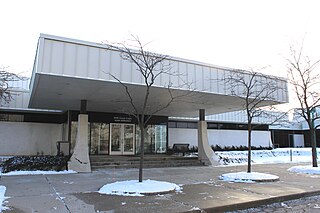
Ann Arbor is a city in and the county seat of Washtenaw County, Michigan, United States. The 2020 census recorded its population to be 123,851, making it the fifth-largest city in Michigan. It is the principal city of the Ann Arbor Metropolitan Statistical Area, which encompasses all of Washtenaw County. Ann Arbor is also included in the Greater Detroit Combined Statistical Area and the Great Lakes megalopolis, the most populated and largest megalopolis in North America.

The Huron River is a 130-mile-long (210 km) river in southeastern Michigan, rising out of the Huron Swamp in Springfield Township in northern Oakland County and flowing into Lake Erie, as it forms the boundary between present-day Wayne and Monroe counties. Thirteen parks, game areas, and recreation areas are associated with the river, which passes through the cities of Dexter, Ann Arbor, Ypsilanti, Belleville, Flat Rock and Rockwood that were developed along its banks.

M-17 is a 6.390-mile-long (10.284 km) state trunkline highway in the U.S. state of Michigan, connecting the cities of Ypsilanti and Ann Arbor in Washtenaw County. It was once part of a highway that spanned the southern Lower Peninsula of Michigan before the creation of the U.S. Highway System in 1926. The designation once extended into downtown Detroit, but the eastern terminus was progressively scaled back in the late 1960s to the current location in Ypsilanti. The changes made to the highways in Washtenaw County spawned Business M-17, a business loop for 11 years between 1945 and 1956.

Oceanic and Atmospheric Research (OAR) is a division of the National Oceanic and Atmospheric Administration (NOAA). OAR is also referred to as NOAA Research.

EOTECH is an American company that designs, manufactures, and markets electro-optic and night vision products and systems. The company is headquartered in Plymouth, Michigan. They produce holographic weapon sights for small arms that have been adopted by various military and law enforcement agencies as close quarters battle firearm sights.

University of Michigan Medicine is the academic medical center of the University of Michigan in Ann Arbor. It consists of the University of Michigan Medical School, university hospitals, and affiliated healthcare centers.
Emmett Norman Leith was a professor of electrical engineering at the University of Michigan and, with Juris Upatnieks of the University of Michigan, the co-inventor of three-dimensional holography.
Lloyd Cross is an American physicist and holographer.
The Michigan Aeronautical Research Center (MARC) was one of America's leading air research organizations, run by the University of Michigan at Willow Run Airport. It played a leading role in the creation of the Bomarc Missile Program, alongside Boeing.

The Ypsilanti Public School District was a public school district in Ypsilanti Township, Michigan, and serving Ypsilanti. Its State of Michigan School District code was 81020. It merged with Willow Run Community Schools and formed Ypsilanti Community Schools in 2013.
Geographic Information Systems (GIS) are an increasingly important component of business, healthcare, security, government, trade, media, transportation and tourism industries and operations in China. GIS software is playing an increasing role in the way Chinese companies analyze and manage business operations.

Altarum is a nonprofit research and consulting organization that serves government health insurers, health foundations, and other nonprofit clients that focus on health and health care. Altarum traces its history back to 1946 as Willow Run Laboratory in Ypsilanti, Michigan. In 1972, Willow Run became the Environmental Research Institute of Michigan (ERIM). In 2001, ERIM acquired Vector Research, Inc., a health care information system company, and changed its name to Altarum.

The Michigan Tech Research Institute (MTRI) is a research center of Michigan Technological University located in Ann Arbor, Michigan. The institute specializes in advancing the state of the art in remote sensing and information technology for a variety of applications.

Ypsilanti, commonly shortened to Ypsi, is a city in Washtenaw County in the U.S. state of Michigan. As of the 2020 census, the city's population was 20,648. The city is bounded to the north by Superior Township and on the west, south, and east by Ypsilanti Township. It is home of Eastern Michigan University.

Barry N. Haack is an American geographer and Emeritus Professor in the Department of Geography and Geoinformation Science at George Mason University in Fairfax, Virginia. He is an international authority on remote sensing, geographic information systems (GIS), and technology transfer from developed to developing nations. Haack is a visiting physical scientist at the United States Geological Survey and an elected Fellow in the American Society for Photogrammetry and Remote Sensing (ASPRS). Through education and collaboration, Haack has influenced the careers of scientists and decision makers from many United States federal agencies and in universities and agencies in nearly thirty countries. He has held formal arrangements with the United Nations, World Bank, Inter-American Development Bank, NASA, the European Space Agency, the National Geographic Society, and many other international organizations and country governmental agencies.

The Chengdu University of Information Technology, formerly the Chengdu Meteorological College (成都气象学院), is a provincial public university in Chengdu, Sichuan, China. The university is affiliated with the Province of Sichuan, and co-sponsored by the China Meteorological Administration and the Sichuan Provincial Government.
Juris Upatnieks is a Latvian-American physicist and inventor, and pioneer in the field of holography.

Kamal Sarabandi is an Iranian-American scientist and the Fawwaz T. Ulaby Distinguished University Professor of EECS and the Rufus S. Teesdale endowed Professor of Engineering at the University of Michigan, where he teaches and conducts research on the science and technology of microwave and millimeter wave radar remote sensing, wireless technology, electromagnetic wave propagation and scattering, metamaterials, antenna miniaturization, and nano antennas.

Ypsilanti Community Schools (YCS) is a K-12 school district headquartered in Ypsilanti Township, Michigan.
Maxar Technologies Inc. is a space technology company headquartered in Westminster, Colorado, United States, specializing in manufacturing communication, Earth observation, radar, and on-orbit servicing satellites, satellite products, and related services. DigitalGlobe and MDA Holdings Company merged to become Maxar Technologies on October 5, 2017.













